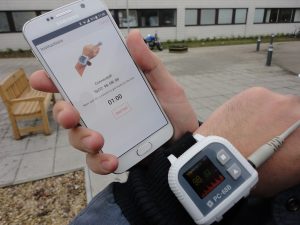Originally published by Guardian Healthcare Professionals Network, 29 March 2017
A six minute walk test is more work than it sounds. It measures a patient’s health by getting them to walk up and down a measured length of corridor wearing a finger sensor that records blood oxygen level and pulse, with two healthcare professionals counting the turns and monitoring the sensor data.

“The corridor is used by lots of different people,” says Dr Elizabeth Orchard, a consultant cardiologist at Oxford University Hospitals foundation trust. “Anybody who walks along there, any beds that come along there, any trolleys, it’s very difficult to continue walking.” At Oxford’s John Radcliffe hospital, the nearest suitable corridor is about 200 metres from the cardiology outpatient department. “If they have to walk, they’ve already done half of their six minute walk test,” she says. If they wait for a porter to move them in a wheelchair, “a test that takes six minutes to do is taking half an hour”.
“I’ve seen physicians get the numbers sometimes wrong,” adds Dario Salvi, an engineering science research assistant at Oxford University. “You start talking with the patient and you miss one turn.” The standard stretch of corridor is 25 metres and Dr Orchard’s pulmonary hypertension patients may walk less than 500 metres in the six minutes, so a couple of missed turns makes a big difference. Although echocardiograms and the patient’s own reports are taken into account, “we are deciding on expensive therapies depending on the results of this,” she says.
So the trust is testing wearable technology to let patients carry out walk tests at home. Since summer 2015 Salvi, who works at Oxford University’s institute of biomedical engineering, has worked with Dr Orchard to build a smartphone app that records tests carried out inside using a measured stretch of corridor with the smartphone’s motion sensors counting turns, or ideally outside where it can use GPS location tracking. Blood oxygen level and pulse are taken at the fingertip by a medically-tested wearable device that sends the data to the smartphone using Bluetooth wireless technology.
They are currently testing the system with around 10 patients, and although not yet used for treatment decisions, its data has already provided insights.
Salvi shows an online graph for one patient’s recent outdoor six-minute walk with pulse staying at a low 50 beats per minute; Dr Orchard says this was because the patient’s pacemaker failed to respond to increased physical activity, and will be adjusted.
Results from the app will be compared against the standard in-hospital tests and it could be available for clinical purposes in 2018. Dr Orchard says using it would save patients from unnecessary hospital trips but also allow clinicians to make quicker decisions on changing types or levels of drugs.
As well as specific walk tests the system also records other activity by patients when this is gathered by their smartphone. Other trials of wearable focus on this kind of data, which monitors patients whenever they carry their smartphones.
Dorset Epilepsy Service is issuing up to 200 Microsoft Band 2 fitness wristbands to its patients, which use 11 sensors to record data that includes sleep and activity patterns. Dr Rupert Page, the service’s clinical lead, says that the wristband data can reliably detect around 85% of the most serious generalised tonic clonic seizures. But absence seizures, a loss of awareness that may last just 30 seconds, cannot be detected by the wristband so patients use a smartphone app to record them.
The aim is to use both types of data to work out when patients are more likely to experience seizures. “All of these things allow us to develop new insights for patients from that data,” says Dr Page.
He says that the trial chose a commercially-available fitness wristband rather than a medical one: “There’s a lot of stigma attached to epilepsy,” he says. Smartwatches were considered, but they needed recharging too often – running all the sensors constantly drains their batteries. Microsoft’s Band 2 was chosen as it has open interfaces and a good range of sensors, although the product will soon be withdrawn.
King’s Health Partners academic health science centre is using healthcare-focused wristbands from Buddi to examine how to help patients can avoid developing type 2 diabetes. It plans to involve around 200 patients in Southwark and Lambeth, chosen by applying algorithms to GP-held data to find people who have high blood sugar levels that indicate a high risk of diabetes.
Some participants will also get an app that coaches people to improve their health, using physical activity data gathered by the wristband and a standard workbook of advice. “The idea is to continually motivate people in a positive way, suggesting solutions to potential barriers,” says Dr David Hopkins, the centre’s joint clinical academic group lead. Other participants will just see activity data such as number of steps taken, without the associated advice.
The trial will test the theory that people need coaching as well as data to change their lifestyles. “Some of the initial studies with wearable technology have been a bit disappointing,” says Hopkins, where users just see data. To make long-term changes, people typically require opportunities, motivation and continuous reinforcement from healthcare professionals: “We believe by providing it in an automated way we can achieve the same,” he says.
